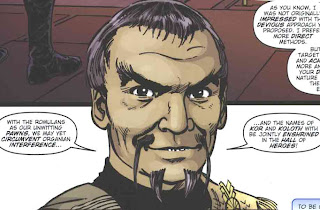I don't often wander through my comic shop's licensed property section, but questing for the most recent issue of
Godzilla: the Half-Century War led me past their Star Trek display. I just happened to spy the new
Star Trek: Romulans Treasury Edition; actually, it's size made it rather difficult to overlook.
It's not the largest comic book I own, but the "treasury edition" format always makes me giddy. In this instance, it led me into buying a Star Trek comic book I would have overlooked if the same material had been sold as a trade paperback (as is, the $9.99 price was cheaper than the cover price of the original material).

This book collects three comic books about Romulans which writer-penciler-inker John Byrne created in 2008. Set in the continuity of the 1960s TV show, it opens immediately prior to "Balance of Terror," the episode which introduced the Romulans. The honorable Romulan commander from that episode is (re)introduced, along with his wife, son and the fanatical leader of the Romulans, the Praetor. At the same time the Romulans have begun using their new cloaking devices to cross the Neutral Zone, they've made new allies: the Klingons. On the surface, the Klingons have come to Romulus to obtain their own cloaking devices, but they actually have a secret plan of their own. Considering the Romulans have a reputation in Star Trek for being the galaxy's most cunning spies, there is schadenfreude to be had in seeing them outwitted by Klingons!

It definitely pays to know your 1960s Star Trek before delving into this book. In addition to "Balance of Terror," I recognized references to "the Trouble With Tribbles," "Errand of Mercy" and "the Deadly Years." Because all of this is told from the perspective of the Romulans (and Klingon allies), the Starfleet characters are only ever glimpsed from a distance (although despite being absent from the cast of characters, one James T. Kirk sets into motion much of the action). If you don't recall how "Balance of Terror" played out, you may be confused by how the Romulan commander is given a great introduction, then dies off-panel in battle with the Enterprise. And while you might recognize the Klingons Koloth & Kor from (respectively) "the Trouble With Tribbles" and "Errand of Mercy," Kor's motivation depends on you being familiar with "Errand of Mercy"'s plot. Essentially, having been forcibly prevented by the all-powerful Organians from attacking the Federation, Kor's great scheme is to manipulate the Romulans into waging war on their behalf. He does refer to the "Organian interference," but it's up to the reader to understand its context.

Being printed at such a large size means when Byrne delves into great detail at rendering the people or starships, you can marvel at his skill. However, it also means when Byrne takes shortcuts with his art, the increased size makes it all the more glaring. Let's call it a draw.
The book would definitely profit from a few endnotes to explain the continuity. For that matter, the story could use captions to help with scene transitions. There are moments where knowing how many days/weeks have passed between scenes would help explain the seemingly drastic changes in situation. Further, one sequence presents the Klingons & Romulans engaged in war games, but because the Romulans have a team of Klingon observers aboard their ship, I had difficulty understanding when the perspective switched between vessels.
This isn't the complete story - Byrne wrote three more comics about the Romulans which will reprinted in a 2nd treasury edition to accompany this. I didn't realize it when I bought this book, but I'll happily add the concluding volume to my collection; Byrne and Star Trek are both fond old friends of mine and it's a pleasure to revisit them.















